As we know climate can have an impact on agriculture, urban, and environmental systems. This is why my interest was piqued when a report crossed my desk about very specific climate indicators in the Southeast. For today’s blog, let’s dig into this report and then look at how it will ultimately impact vertical industries like agriculture.
The report looks at one very specific region—Southeast Florida—but it provides a good representation of similar climate indicators for the entire Southeast. In the Southeast Florida Climate Indicators report, we see while sea level rise frequently receives the most attention in the region, there are other impacts that have consequences for communities and for industries like agriculture.
But, first, let’s back up a minute. What exactly is climate? To be very candid, we all have a very different perception and view of what this seven-letter word means.
All about Climate
At its core, climate is generally defined as “average weather,” usually described in terms of the mean and variability of temperature, precipitation, and wind over a period of time. Now that we have that covered, let’s take a moment to review some of the indicators from the report.
Temperature: During the last 100 years, the average maximum temperature across the region has increased at an average rate of 0.23 °F per decade, and in the last 50 years, it has increased 0.29 °F per decade.
Precipitation: Long-term averages indicate South Florida has an annual rainfall of 52 to 53 inches, with roughly three-quarters of the rainfall occurring in the wet season and the transitional months.
Sea level: The observed sea level rise at the Key West tide gauge from 2000 to 2023 is about six inches. In the period from 2012 to 2023, there was a rapid increase in monthly sea level rise along the Southeast Florida coast.
 AI-Powered Growth: Driving Forces Behind the Booming Artificial Intelligence in Agriculture Market
AI-Powered Growth: Driving Forces Behind the Booming Artificial Intelligence in Agriculture Market
Sea surface temperature: More than 90% of the excess heat associated with warming that has happened on Earth during the past 50 years has been transferred to the ocean. From 1982 to 2024, we see an increase in summertime sea surface temperature in the region of nearly half a degree (0.49 °F) per decade.
What’s Happening with Ag
Certainly, climate impacts agriculture in a very direct way—it always has, and it always will. Temperature, rainfall, humidity, and sunlight are core inputs in the agriculture industry. Climate is key to crop yields, which means data about the climate is essential for farmers. This isn’t new. What is new is the technology that is available to help better understand climate.
To help, a new initiative from the ICRISAT (Intl. Crops Research Institute for the Semi-Arid Tropics) aims to equip smallholder farmers with hyper-local, actionable weather and climate insights, enabling them to make informed decisions amid increasing climate variability.
How? By leveraging AI (artificial intelligence) and ML (machine learning). The project brings together several partners seeking to bridge climate science and farmers’ needs by harnessing new technologies.
Let’s take a closer look. The iSAT (Intelligent Systems Advisory Tool) is a digital platform developed and piloted by ICRISAT and partners during Monsoon Mission II. The technology integrates realtime weather forecasts, crop models, and machine learning analytics. With the right data in hand, farmers will have timely, actionable recommendations for critical decisions such as sowing, irrigation, and pest management.
Of course this is only one example. We saw many IoT (Internet of Things) solutions in agriculture, and now we are seeing a surge of data analytics, machine learning, and AI in ag—and in several vertical markets. What are you seeing in your own industry? As global challenges arise, how can we address them?















